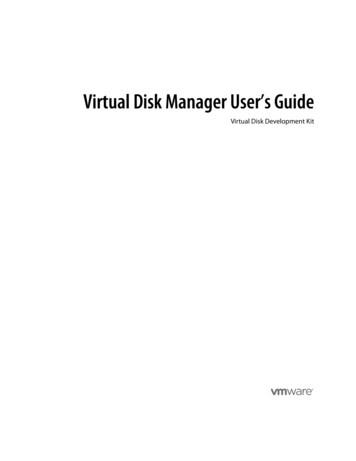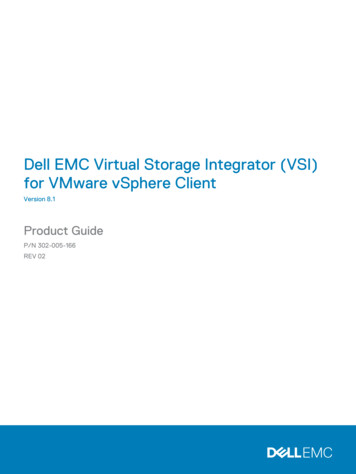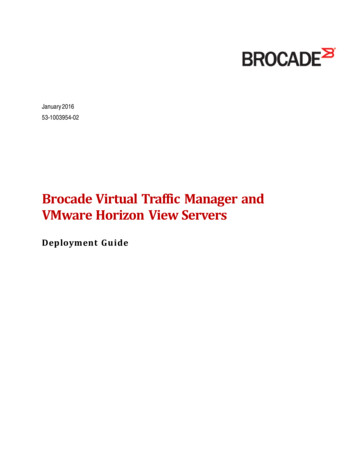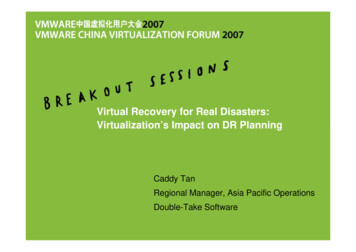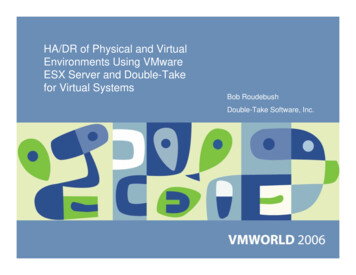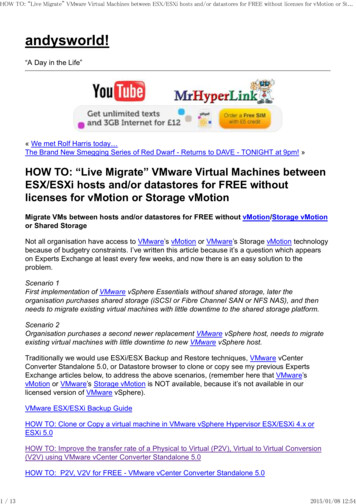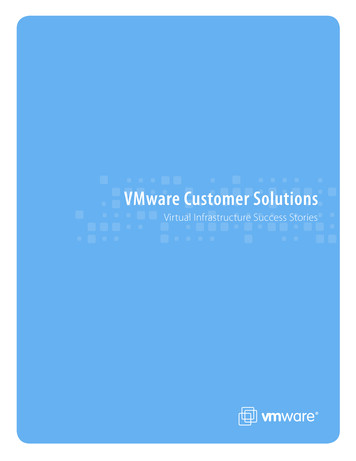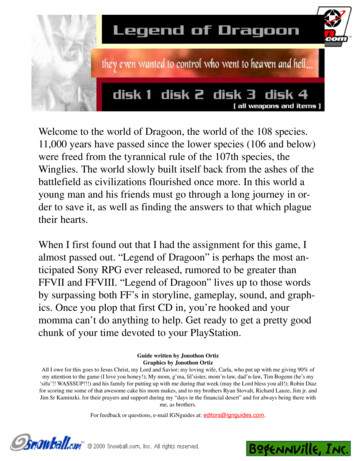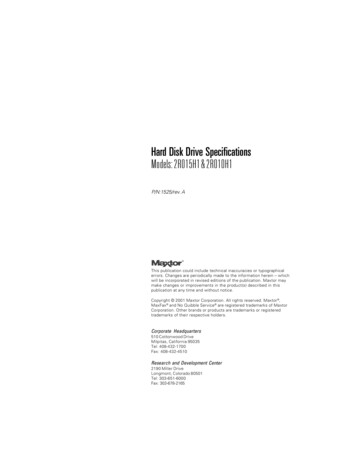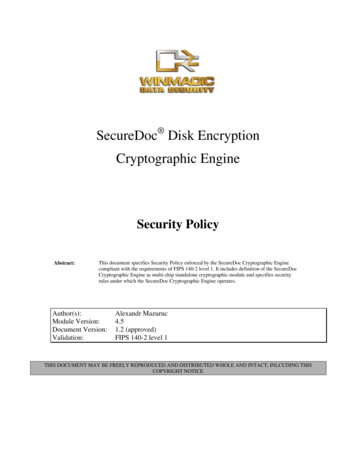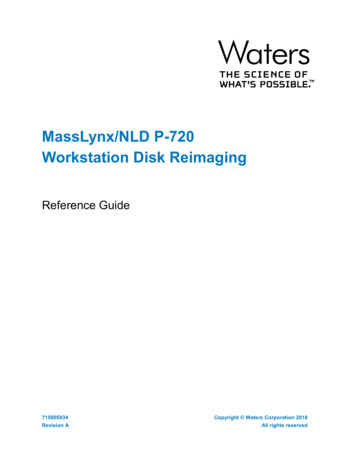
Transcription
VMWARE TECHNICAL NOTEVMware Virtual DisksVirtual Disk Format 1.1Virtual machines created with VMware products typically use virtual disks. The virtual disks,stored as files on the host computer or on a remote storage device, appear to the guestoperating systems as standard disk drives.This technical note begins with a high-level introduction to the layout of the files that make up aVMware virtual disk of the type used by VMware Workstation 4, VMware Workstation 5, VMwareWorkstation 6, VMware Player, VMware Fusion, VMware GSX Server 3, VMware Server, andVMware ESX Server 3. It then drills down into the details of the data structures inside thosevirtual disk files.The document contains the following sections: Layout Basics on page 2 The Descriptor File on page 3 Simple Extents on page 7 Hosted Sparse Extents on page 7 ESX Server Sparse Extents on page 12 Stream-Optimized Compressed Sparse Extents on page 14 Glossary on page 18VMware, Inc. 3401 Hillview Ave., Palo Alto, CA 94304 www.vmware.comCopyright 1998-2007 VMware, Inc. All rights reserved. VMware, the VMware “boxes” logo and design, Virtual SMP andVMotion are registered trademarks or trademarks of VMware, Inc. in the United States and/or other jurisdictions. Microsoft,Windows and Windows NT are registered trademarks of Microsoft Corporation. Linux is a registered trademark of Linus Torvalds.All other marks and names mentioned herein may be trademarks of their respective companies.Revision: 20071113 Version: 1.1 Item: NP-ENG-Q205-099To ensure that readers of this specification have access to the most current version, readers may download copies of thisspecification from www.vmware.com and no part of this specification (whether in hardcopy or electronic form) may bereproduced, stored in a retrieval system, or transmitted, in any form or by any means, electronic, mechanical, photocopying,recording, or otherwise, without the prior written permission of VMware, Inc., except as otherwise permitted under copyrightlaw. Please note that the content in this specification is protected under copyright law even if it is not distributed with softwarethat includes an end user license agreement.This specification and the information contained herein is provided on an “AS-IS” basis, is subject to change without notice, andto the maximum extent permitted by applicable law, VMware, Inc., its subsidiaries and affiliates provide the document AS ISAND WITH ALL FAULTS, and hereby disclaim all other warranties and conditions, either express, implied or statutory, includingbut not limited to, any (if any) implied warranties, duties or conditions of merchantability, of fitness for a particular purpose, ofaccuracy or completeness of responses, of results, of workmanlike effort, of lack of viruses, and of lack of negligence, all withregard to the document. ALSO, THERE IS NO WARRANTY OR CONDITION OF TITLE, QUIET ENJOYMENT, QUIET POSSESSION,CORRESPONDENCE TO DESCRIPTION OR NON-INFRINGEMENT OF ANY INTELLECTUAL PROPERTY RIGHTS WITH REGARD TO THEDOCUMENT.IN NO EVENT WILL VMWARE, ITS SUBSIDIARIES OR AFFILIATES BE LIABLE TO ANY OTHER PARTY FOR THE COST OF PROCURINGSUBSTITUTE GOODS OR SERVICES, LOST PROFITS, LOSS OF USE, LOSS OF DATA, OR ANY INCIDENTAL, CONSEQUENTIAL, DIRECT,INDIRECT, OR SPECIAL DAMAGES WHETHER UNDER CONTRACT, TORT, WARRANTY, OR OTHERWISE, ARISING IN ANY WAY OUT OFTHIS OR ANY OTHER AGREEMENT RELATING TO THIS DOCUMENT, WHETHER OR NOT SUCH PARTY HAD ADVANCE NOTICE OFTHE POSSIBILITY OF SUCH DAMAGES.1
Virtual Disk Format 1.1Virtual machines created by VMware products other than VMware Workstation 4, VMwareWorkstation 5, VMware Workstation 6, VMware Fusion, VMware GSX Server 3, VMware Server,and VMware ESX Server 3 may use formats different from those described in this document. Keyareas that are not discussed in this technical note include the following: Virtual disks created in legacy mode in Workstation 5, or virtual disks created in ESX Server2 or earlier, GSX Server 3 or earlier, Workstation 4 or earlier, or VMware ACE Device-backed virtual disks Encryption Encrypted extents Encrypted descriptor files Defragmenting a virtual disk Shrinking a virtual disk Consolidating virtual disksLayout BasicsVMware virtual disks can be described at a high level by looking at two key characteristics. The virtual disk may use backing storage contained in a single file, or it may use storagethat consists of a collection of smaller files. All of the disk space needed for a virtual disk’s files may be allocated at the time the virtualdisk is created, or the virtual disk may start small and grow only as needed to accomodatenew data.A particular virtual disk may have any combination of these two characteristics.One common characteristic of recent-generation VMware virtual disks is that a text descriptordescribes the layout of the data in the virtual disk. This descriptor may be saved as a separate fileor may be embedded in a file that is part of a virtual disk. The section titled The Descriptor Fileon page 3 explains the information contained in the descriptor.The way a virtual disk uses storage space on a physical disk varies, depending on the type ofvirtual disk you select when you create the virtual machine.Initially, for example, a virtual disk consists of only the base disk. If you take a snapshot of a virtualmachine, its virtual disk includes both the base link and a delta link (referred to in some productdocumentation as a redo-log file). Changes the guest operating system has written to disk sinceyou took the snapshot are stored in the delta link. It is possible for more than one delta link to beassociated with a particular base disk.Think of the base disk and the delta links as links in a chain. The virtual disk consists of all the linksin the chain.Link ABase diskLink BDelta link 1Link CDelta link 2Links in the chain that makes up the virtual disk2
Virtual Disk Format 1.1Each link in the chain is made up of one or more extents.Extent 0Extent 1Extent 2Extent 3Extents that make up a linkAn extent is a region of physical storage, often a file, that is used by the virtual disk.In the links diagram above, links B and C are necessarily made up of extents that begin small andgrow over time, referred to as sparse extents. Link A can be made up of extents of any kind —sparse, preallocated, or even backed directly by a physical device.The Descriptor FileFor a more detailed view of how these elements of a virtual disk come together in practice, lookat the following example text descriptor file, called test.vmdk. It describes a link in a virtualdisk that is split into files no larger than 2GB each and that starts small and grows as data isadded. The descriptor file is not case-sensitive.Lines beginning with # are comments and are ignored by the VMware program that opens thedisk.% cat test.vmdk# Disk DescriptorFileversion 1CID fffffffeparentCID ffffffffcreateType "twoGbMaxExtentSparse"# Extent descriptionRW 4192256 SPARSE "test-s001.vmdk"RW 4192256 SPARSE "test-s002.vmdk"RW 2101248 SPARSE "test-s003.vmdk"# The Disk Data Base#DDBddb.adapterType "ide"ddb.geometry.sectors "63"ddb.geometry.heads "16"ddb.geometry.cylinders "10402"The HeaderThe first section of the descriptor is the header. It provides the following information about thevirtual disk: versionThe number following version is the version number of the descriptor. The default valueis 1. CIDThis line shows the content ID. It is a random 32-bit value updated the first time thecontent of the virtual disk is modified after the virtual disk is opened.Every link header contains both a content ID and a parent content ID (described below).If a link has a parent — as is true of links B and C in the diagram of links in a chain — theparent content ID is the content ID of the parent link.3
Virtual Disk Format 1.1If a link has no parent — as is true of link A in the diagram of links in a chain — the parentcontent ID is set to CID NOPARENT (defined below).The purpose of the content ID is to check the following: In the case of a base disk with a delta link, that the parent link has not changed since thetime the delta link was created. If the parent link has changed, the delta link must beinvalidated. That the bottom-most link was not modified between the time the virtual machine wassuspended and the time it was resumed or between the time you took a snapshot ofthe virtual machine and the time you reverted to the snapshot. parentCIDThis line shows the content ID of the parent link — the previous link in the chain — if thereis one. If the link does not have any parent (in other words, if the link is a base disk), theparent’s content ID is set to the following value:#define CID NOPARENT( 0x0) createTypeThis line describes the type of the virtual disk. It can be one of the following: monolithicSparse vmfsSparse monolithicFlat vmfs twoGbMaxExtentSparse twoGbMaxExtentFlat fullDevice vmfsRaw partitionedDevice vmfsRawDeviceMap vmfsPassthroughRawDeviceMap streamOptimizedThe first six terms are used to describe various types of virtual disks. Terms that includemonolithic indicate that the data storage for the virtual disk is contained in a single file.Terms that include twoGbMaxExtent indicate that the data storage for the virtual diskconsists of a collection of smaller files. Terms that include sparse indicate that the virtualdisks start small and grow to accommodate data. Some product documentation refers tothese virtual disks as growable disks. Terms that include flat indicate that all spaceneeded for the virtual disks is allocated at the time they are created. Some productdocumentation refers to these virtual disks as preallocated disks.Terms that include vmfs indicate that the disk is an ESX Server disk.The terms fullDevice, vmfsRaw, and partitionedDevice are used when thevirtual machine is configured to make direct use of a physical disk — either a full disk orpartitions on a disk — rather than store data in files managed by the host operatingsystem.4
Virtual Disk Format 1.1The terms vmfsRawDeviceMap and vmfsPassthroughRawDeviceMap are usedin headers for disks that use ESX Server raw device mapping.The term streamOptimized is used to describe disks that have been optimized forstreaming. parentFileNameHintThis line, present only if the link is a delta link, contains the path to the parent of the deltalink.The ExtentsEach line of the second section describes one extent. The extents are enumerated beginningwith the one accessible at offset 0 from the virtual machine’s point of view. The format of the linelooks like one of the following examples:RW 4192256 SPARSE "test-s001.vmdk"AccessType of extentFilenameSize in sectorsRW 1048576 FLAT "test-f001.vmdk" 0AccessType of extentFilenameOffsetSize in sectorsThe extent descriptions provide the following key information: Access — may be RW, RDONLY, or NOACCESS Size in sectors — a sector is 512 bytes Type of extent — may be FLAT, SPARSE, ZERO, VMFS, VMFSSPARSE, VMFSRDM, orVMFSRAW. Filename — shows the path to the extent (relative to the location of the descriptor)Note: If the type of the virtual disk, shown in the header, is fullDevice orpartitionedDevice, then the filename should point to an IDE or SCSI block device. If thetype of the virtual disk is vmfsRaw, the filename should point to a file in /vmfs/devices/disks/. Offset — the offset value is specified only for flat extents and corresponds to the offset inthe file or device where the guest operating system’s data is located. For preallocatedvirtual disks, this number is zero. For device-backed virtual disks (physical or raw disks), itmay be non-zero.5
Virtual Disk Format 1.1The Disk DatabaseAdditional information about the virtual disk is stored in the disk database section of thedescriptor. Each line corresponds to one entry. Each entry is formatted as follows:ddb. nameOfEntry " value of entry "When the virtual disk is created, the disk database is populated with entries like those shown inthe example descriptor. The entry names are self-explanatory and show the followinginformation: The adapter type can be ide, buslogic, lsilogic, or legacyESX. The buslogicand lsilogic values are for SCSI disks and show which virtual SCSI adapter is configuredfor the virtual machine. The legacyESX value is for older ESX Server virtual machineswhen the adapter type used in creating the virtual machine is not known. The geometry values — for cylinders, heads, and sectors — are initialized with thegeometry of the disk, which depends on the adapter type.There is one descriptor, and thus one disk database, for each link in a chain. Searches for diskdatabase information begin in the descriptor for the bottom link of the chain — Link C in theillustration of links in the chain — and work their way up the chain until the information is found.Layout of the Example DiskThe link described in the example descriptor has three extents, each of which is a file on disk.The following diagram shows the layout of this link and the filenames of the 6
Virtual Disk Format 1.1Simple ExtentsThe simplest kinds of extents are backed by a region of a file or a block device. These include theextent types shown in the descriptor as FLAT, VMFS, VMFSRDM, or VMFSRAW.Note: A virtual disk described as monolithic and flat consists of two files. One file contains thedescriptor. The other file is the extent used to store virtual machine data.Consider an extent that is described by the following line in a descriptor file:RW 1048576 FLAT "test-f001.vmdk" 0This means that the file test-f001.vmdk is1048576 sectors 512 bytes/sector 536870912bytes 512MB in size.Note: In VMware ESX Server, each link includes only one extent.Accessing a Sector in a Flat ExtentAssume you want access to data in a link that is made up of two flat extents. The size of the firstextent is C1. The size of the second extent is C2. You want access to sector x in the virtual disk,and x' is the sector offset in extent 1 or 2 where x is located. If x C1, the sector is in extent2. Its relative sector offset isx' x – C1 If x C1, the sector is in extent1 at offset x.x' xHosted Sparse ExtentsIn a sparse extent, data storage space is not allocated in advance. Instead, space is allocated as itis needed. A sparse extent also keeps track of whether or not data is represented in the extent.Delta links made up of sparse extents use the copy-on-write semantic.Each sparse extent is made up of the following blocks:Sparse headerEmbedded descriptor(Optional)Redundant grain directoryRedundant grain table #0.Redundant grain table #nGrain directoryGrain table #0.Grain table #n(Padding to grain align)GrainGrain.7
Virtual Disk Format 1.1Hosted Sparse Extent HeaderThe following example shows the content of a sparse extent’s header from a VMware hostedproduct, such as VMware Workstation, VMware Player, VMware ACE, VMware Server, or VMwareGSX Server:typedef uint64 SectorType;typedef uint8 Bool;typedef struct SparseExtentHeader ad[433];} SparseExtentHeader;This structure needs to be packed. If you use gcc to compile your application, you must use thekeyword attribute (( packed )).Notes All the quantities defined as SectorType are in sector units. magicNumber is initialized with#define SPARSE MAGICNUMBER 0x564d444b /* 'V' 'M' 'D' 'K' */This magic number is used to verify the validity of each sparse extent when the extent isopened. versionThe value of this entry should be 1. flags contains the following bits of information in the current version of the sparseformat: bit 0: valid new line detection test. bit 1: redundant grain table will be used. bit 16: the grains are compressed. The type of compression is described bycompressAlgorithm. bit 17: there are markers in the virtual disk to identify every block of metadata or dataand the markers for the virtual machine data contain a LBA8
Virtual Disk Format 1.1 grainSize is the size of a grain in sectors. It must be a power of 2 and must be greaterthan 8 (4KB). capacity is the capacity of this extent in sectors — should be a multiple of the grainsize. descriptorOffset is the offset of the embedded descriptor in the extent. It isexpressed in sectors. If the descriptor is not embedded, all the extents in the link have thedescriptor offset field set to 0. descriptorSize is valid only if descriptorOffset is non-zero. It is expressed insectors. numGTEsPerGT is the number of entries in a grain table. The value of this entry forVMware virtual disks is 512. rgdOffset points to the redundant level 0 of metadata. It is expressed in sectors. gdOffset points to the level 0 of metadata. It is expressed in sectors. overHead is the number of sectors occupied by the metadata. uncleanShutdown is set to FALSE when VMware software closes an extent. After anextent has been opened, VMware software checks for the value of uncleanShutdown. If it isTRUE, the disk is automatically checked for consistency. uncleanShutdown is set to TRUEafter this check has been performed. Thus, if the software crashes before the extent isclosed, this boolean is found to be set to TRUE the next time the virtual machine ispowered on. Four entries are used to detect when an extent file has been corrupted by transferring itusing FTP in text mode. The entries should be initialized with the following values:singleEndLineChar '\n';nonEndLineChar ' ';doubleEndLineChar1 '\r';doubleEndLineChar2 '\n'; compressAlgorithm describes the type of compression used to compress every grainin the virtual disk. If bit 16 of the field flags is not set, compressAlgorithm isCOMPRESSION NONE.#define COMPRESSION NONE0#define COMPRESSION DEFLATE1The deflate algorithm is described in RFC 1951.9
Virtual Disk Format 1.1Hosted Sparse Extent MetadataThere are two levels of metadata in a sparse extent from a hosted VMware product. Level-0metadata is called a grain directory or a GD. Level-1 metadata is called a grain table or a GT. Eachentry in the level-0 metadata points to a block of level-1 metadata, as shown in the followingdiagram:GDE#0 GTE#0GTE#1GTE#2GTE#3.GDE#1 GTE#0GTE#1GTE#2GTE#3.GDE#2 GDE#3GTE#0GTE#1GTE#2GTE#3. .GD: level 0GTs: level 1RedundancyVMware software keeps two copies of the grain directories and grain tables on disk to improvethe virtual disk’s resilience to host drive corruption.Grain DirectoryEach entry in a grain directory is called a grain directory entry or GDE. A grain directory entry isthe offset in sectors of a grain table in a sparse extent. The number of grain directory entries pergrain directory (the size of the grain directory) depends on the length of the extent. A graindirectory entry is a 32-bit quantity.Grain TableEach entry in a grain table is called a grain table entry or GTE. A grain table entry points to theoffset of a grain in the sparse extent. There are always 512 entries in a grain table, and a graintable entry is a 32-bit quantity. Consequently, each grain table is 2KB.In a newly created sparse extent, all the grain table entries are initialized to 0, meaning that thegrain to which each grain table entry points is not yet allocated. Once a grain is created, thecorresponding grain table entry is initialized with the offset of the grain in the sparse extent insectors.Note: All the grain tables are created when the sparse extent is created, hence the graindirectory is technically not necessary but has been kept for legacy reasons. If you disregard theabstraction provided by the grain directory, you can redefine g
VMware virtual disk of the type used by VMware Workstation 4, VMware Workstation 5, VMware Workstation 6, VMware Player, VMware Fusion, VMware GSX Server 3, VMware Server, and VMware ESX Server 3. It then drills down into the details of the data structures inside those virtual
